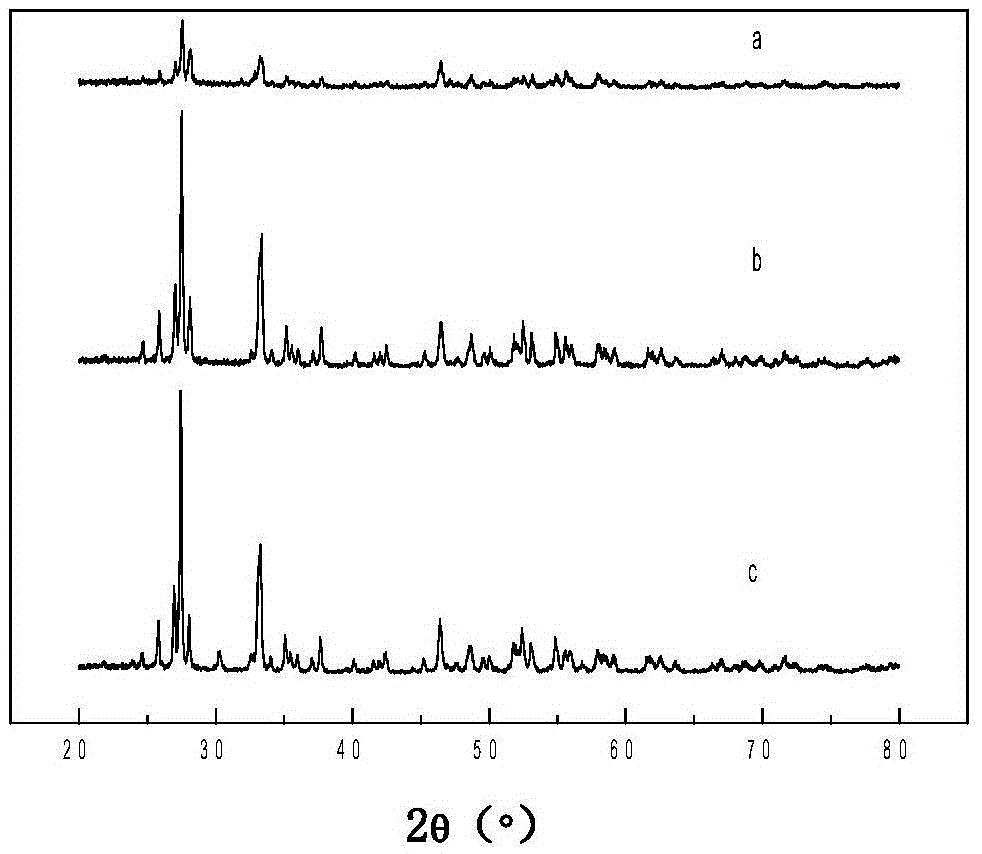A kind of method for preparing nano-bismuth oxide by liquid phase precipitation method
A nano-bismuth oxide, liquid-phase precipitation technology, applied in the field of nano-materials, can solve the problems of high energy consumption and long reaction period, and achieve the effects of low preparation cost, good morphology, and easy control of operating conditions
- Summary
- Abstract
- Description
- Claims
- Application Information
AI Technical Summary
Problems solved by technology
Method used
Image
Examples
Embodiment 1
[0023] Take 14g NaOH in a beaker, add 175mL deionized water and stir to dissolve, then add 1.5g sodium lignosulfonate, and magnetically stir to dissolve evenly. Heat in a water bath until the solution temperature reaches 80°C; then add 25mL of 0.2M Bi(III) dropwise to control the formation of drops but not lines. After the solution was reacted in a constant temperature water bath for 1 hour, it was filtered and washed while it was hot, baked in a constant temperature oven at 60°C for 24 hours, and then calcined in a muffle furnace at 500°C for 3 hours. The XRD pattern of the sample is as follows figure 1 a. Scanning electron microscope picture as figure 2 .
Embodiment 2
[0025] Take 14g NaOH in a beaker, add 175mL deionized water and stir to dissolve, then add 1.0g sodium lignosulfonate, and magnetically stir to dissolve evenly. Heat in a water bath until the solution temperature reaches 80°C; then add 25mL of 0.2M Bi(III) dropwise to control the formation of drops but not lines. After the solution was reacted in a constant temperature water bath for 1 hour, it was filtered and washed while it was hot, baked in a constant temperature oven at 60°C for 22 hours, and then calcined in a muffle furnace at 500°C for 3 hours. The XRD pattern of the sample is as follows figure 1 b.
Embodiment 3
[0027] Take 14g NaOH in a beaker, add 175mL deionized water and stir to dissolve, then add 0.5g sodium lignosulfonate, and magnetically stir to dissolve evenly. Heat in a water bath until the solution temperature reaches 75°C; then add 25 mL of 0.2M Bi(III) dropwise to control the formation of drops but not lines. After the solution was reacted in a constant temperature water bath for 1 hour, it was filtered and washed while it was hot, baked in a constant temperature oven at 50°C for 20 hours, and calcined in a muffle furnace at 400°C for 3 hours. The XRD pattern of the sample is as follows figure 1 c.
[0028] figure 1 Among them, a is the XRD spectrum of the sample in Example 1, b in the figure is the XRD spectrum of the sample in Example 2, and c in the figure is the XRD spectrum of the sample in Example 3. figure 1 Among them, the sharper the peak shape, the better the crystallinity. Curve c has the best crystallinity, which shows that the lower the concentration of s...
PUM
| Property | Measurement | Unit |
|---|---|---|
| concentration | aaaaa | aaaaa |
Abstract
Description
Claims
Application Information
 Login to View More
Login to View More - R&D
- Intellectual Property
- Life Sciences
- Materials
- Tech Scout
- Unparalleled Data Quality
- Higher Quality Content
- 60% Fewer Hallucinations
Browse by: Latest US Patents, China's latest patents, Technical Efficacy Thesaurus, Application Domain, Technology Topic, Popular Technical Reports.
© 2025 PatSnap. All rights reserved.Legal|Privacy policy|Modern Slavery Act Transparency Statement|Sitemap|About US| Contact US: help@patsnap.com


